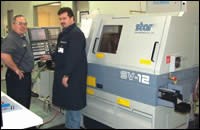Implanting Productivity
With the new software, programming is done off-line at the company with completed programs being sent to the machine. As result, setup time is reduced because it takes very little to prove out the program at the machine. Before implementing the system, a lot more time was spent at the machine writing and editing the program before the first part was made.
Knowledge-based machining is a term you hear a lot these days. For Paragon Implant (Calabasas Hills, California), a 50-employee manufacturer of dental implants, knowledge-based machining has a special meaning. Although new in the business, the company has been manufacturing dental implants since 1989 when its founder, Dr. Gerald Niznick, started a company called Core-Vent Bio-Engineering to create his patented designs. The original company was sold in January 2001. However, when Dr. Niznick decided to return to dental implant manufacturing at Paragon Implant in late 2004, he assembled a team of veterans who worked for him in the past and worked for the company that acquired his prior implant business. Therefore, these employees had a lot of experience in this niche.
One of the first bottlenecks the Paragon team addressed was the issue of programming. Paragon started with a bank of 16 CNC Swiss-type lathes to manufacture its dental implants, including Star CNC SV-12, ECAS-12 and SB-16 models. The company also has a toolroom equipped with a Haas five-axis mill and an Emco-Maier turn-mill among other machines. The predecessor company to Paragon had a similar mix of equipment, all of which was programmed in quasi-manual fashion with a lot of cutting and pasting. Much of the programming was being done manually by setup personnel at the machine.
"The way we used to program left a lot of room for error where you could easily crash the machine," says Bill Aravena, a CNC specialist at the company who is responsible for programming the CNC Swiss machines.
Reduced Setup Time
To alleviate the programming bottleneck that Paragon's predecessors had, the company turned to PartMaker Software from IMCS Inc. The company found PartMaker to be a highly intuitive program for all of its CNC applications.
"Starting out as a new company, we researched CAM systems for our programming. When we came across PartMaker, we saw it was really designed to support Swiss machines," according to Wayne Smith, tooling manager, who programs all the toolroom machines and helps with programming the CNC Swiss machines.
"Once you know one module, you know them all. It is really user friendly. For people who think like machinists, the system is intuitive, he says.
With the new system, programming is done off-line with completed programs being sent to the machine. As result, setup time is reduced because it takes very little to prove out the program at the machine. Before implementing the system, a lot more time was spent at the machine writing and editing the program before the first part was made.
"PartMaker has helped significantly because it allows me to generate accurate programs the first time, directly from an imported solid model from SolidWorks," Mr. Aravena says.
Master Setup Man
Although he now does CNC programming, Mr. Aravena came from the shop floor. With Paragons' predecessors, he was a setup technician. By using PartMaker off-line, he not only programs the part, but fully simulates the machining process using the software's integrated 3D machining simulation before sending the program to the machine.
By programming and proving out parts off-line, not only is Paragon able to program and set up faster, but it has made the company's setup operators more productive by taking the programming burden off the shop floor.
"With the new program, we can see everything ahead of time on the computer," Mr. Aravena explains. The software allows him to apply his experience as a setup man by giving him a virtual machine environment in which he can prove out part programs before sending them to the shop floor.
Ultimate Flexibility
It is critical that Paragon's manufacturing is flexible while reacting to design modifications made by Dr. Niznick and his engineering department. PartMaker gives Paragon flexibility in the software's input of engineering data and its output of G-code programs.
From an input perspective, the program directly integrates with the SolidWorks engineering software used by Paragon's design engineering department. PartMaker allows Paragon's programmers to directly import models from SolidWorks. Once the model is imported, the part can be quickly programmed without any need to modify or recreate part geometry.
"We have been able to measurably increase throughput in programming because we can pull a SolidWorks part file directly into PartMaker," Mr. Smith says.
Once the model has been imported and cutting strategies have been applied to it, an accurate program is generated because of the robust post processors that come with the software. Each of Paragon's Swiss machines has varied programming requirements, even though they are manufactured by the same company. For example, the Star SV and SB machine come equipped with dual-path Fanuc controls, while the Star ECAS has a three-path Siemens-based control. With just a few clicks of the mouse, Mr. Aravena is quickly able to post-process a program for any of these machines.
"One of the most difficult parts of programming a Swiss machine is keeping up with waiting codes," Mr. Aravena states.
To automate the programming of wait and sync codes, PartMaker uses a patented visual synchronization methodology that makes process synchronization an easy task. Once the process is laid out and the synchronization is done, the software calculates the part's optimized cycle time.
Up And Running
With its demanding production schedule, it was essential that Paragon got PartMaker up and running quickly. Mr. Smith believes that the program's practical training curriculum has made The shop is able to become productive with the software quickly.
"We went through a 4-day class where we got to work on our own parts. To us, that was the greatest thing in the world."
Related Content
Meeting Stringent Cleaning Goals With Modular Ultrasonic System
A knee implant manufacturer implements an advanced cleaning system that meets its tight cleaning requirements, including documenting, validating and tracing the entire cleaning process.
Read MoreThe Control’s Role in Machining Complex Parts
This company that produces medical implants finds value in the CNC for its turn-mill equipment that helps speed setups and simplify programming when producing intricate parts complete.
Read MoreThe Value of Swiss-Types Milling Rectangular Medical Parts
High-speed spindle technology was key to effective milling of small cardiac monitoring components complete on a CNC sliding-headstock machine platform instead of running them across two mills.
Read MoreHow Small Machine Shops Can Fight Supply Chain Problems
Supply chain disruptions are still presenting challenges in manufacturing. This article examines the effects on aerospace, automotive and medical industries. It also covers ways that machine shops can be successful securing work despite the challenges created by the supply chain.
Read MoreRead Next
Do You Have Single Points of Failure?
Plans need to be in place before a catastrophic event occurs.
Read More5 Aspects of PMTS I Appreciate
The three-day edition of the 2025 Precision Machining Technology Show kicks off at the start of April. I’ll be there, and here are some reasons why.
Read MoreEmerging Leaders Nominations Now Open
Here’s your chance to highlight a young person in your manufacturing business who is on the path to be a future leader moving your company forward.
Read More









.jpg;maxWidth=300;quality=90)















